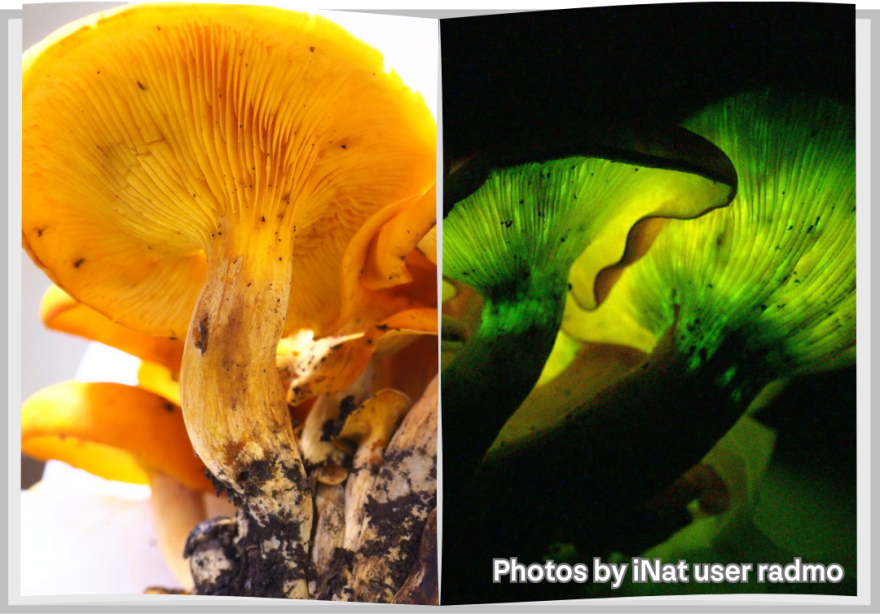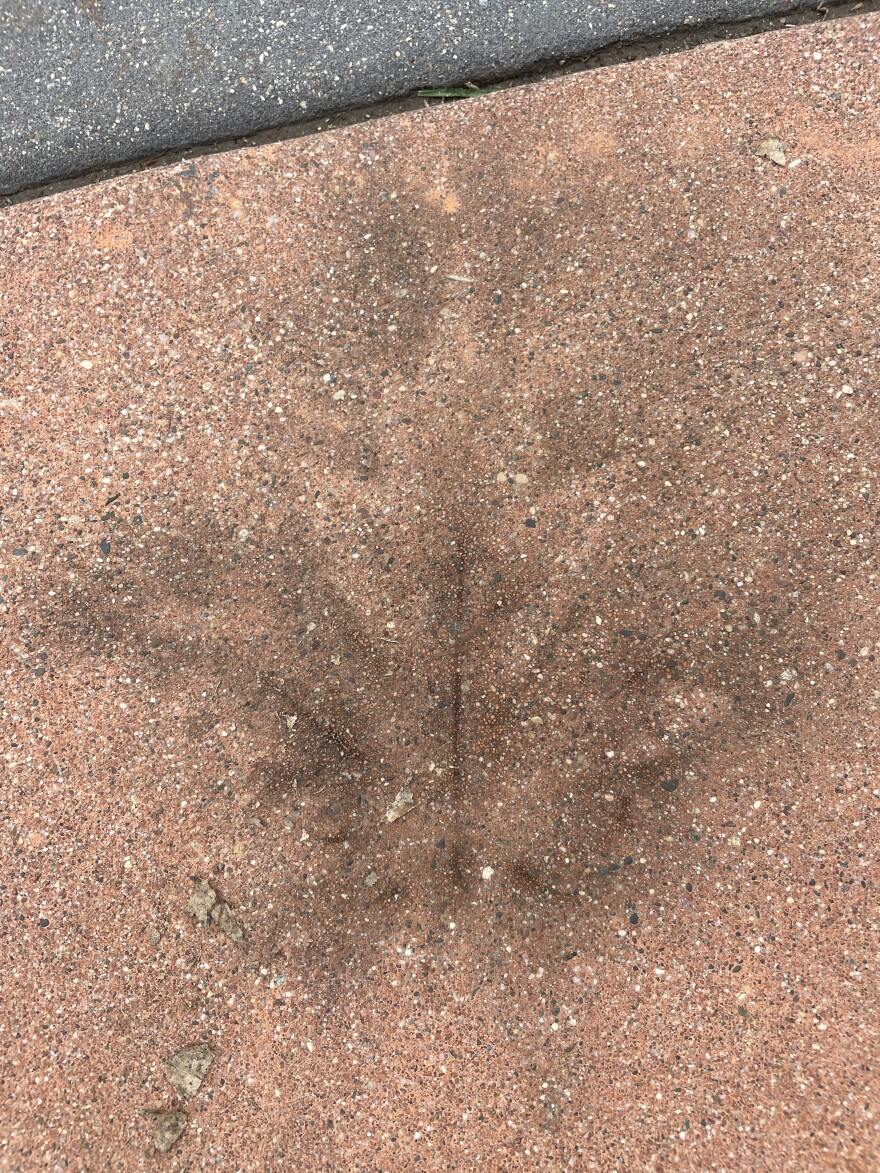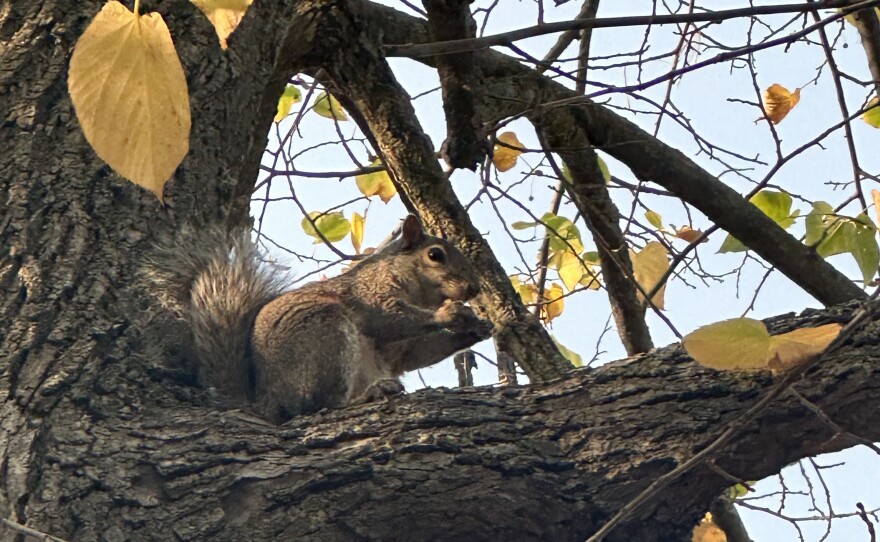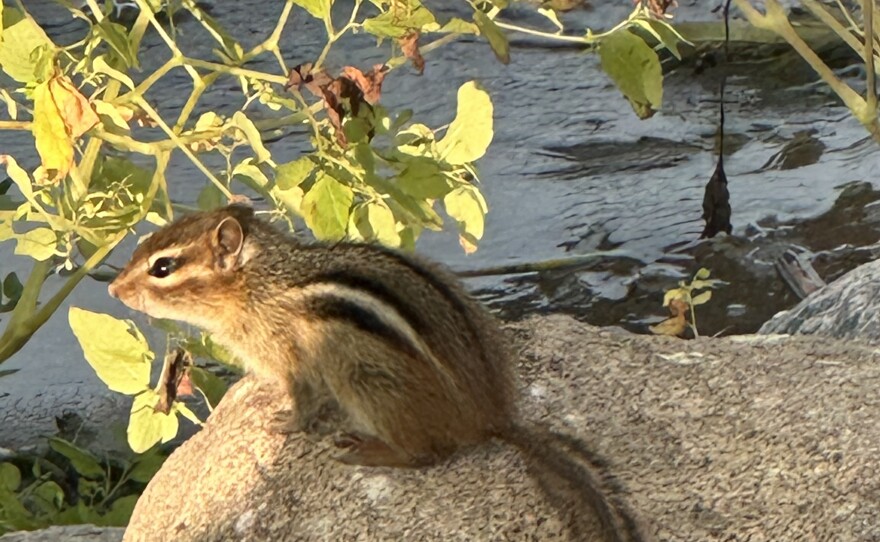We have 11 reports this week, featuring fall colors, clambering porcupines and lots of mushrooms!
Please don’t hesitate to reach out with your observations, nature tales and insights! Get in touch with me (cmitchell@kaxe.org), John Latimer (jlatimer@kaxe.org), or text "phenology" to 218-326-1234.
Lake of the Woods School in Baudette

Wyatt reported from Andrew Pierson’s class at Lake of the Woods School in Baudette:
“This is Wyatt with the phenology report from Baudette Sept. 23-30.
“Lynk has noticed that many farmers and gardeners have been busy harvesting their crops this week.
“Aurora reported her dad seeing a blue-spotted salamander on Monday while moving rocks.
“Finally, on Tuesday, Mrs. Nordlof saw a huge bull moose while driving south of Baudette.”
John is always thrilled to find a blue-spotted salamander. I (Charlie) apparently need to go move some rocks around Baudette, because I haven’t yet found one in the wild!
Apple Blossom Village School in Bemidji

Amara reported from Alexzandra Lucia’s class at Apple Blossom Village in Bemidji:
“This is Amara reporting the Apple Blossom phenology report for the week of Sept. 25.
“It has been warm lately. Trees are losing leaves. We have noticed leaves in red, orange, green, yellow and brown.
“We have been seeing more birds migrating and deer along the roads. Our garden is still growing.
“That’s all for this week!”
John is glad the students are noticing and appreciating the fall colors. He said, “You know, I was driving along the other day and looking at a bright red maple along the road that I live on. And the leaves have been falling off of that tree, and the whole edge of the road there is this long stripe of just beautiful red. Yeah, it's a lovely time of year.”
Science Nature Adventure Program in Bemidji
Lillie reported from Angie Nistler’s Science Nature Adventure Program (SNAP) at Bemidji Middle School:
“Hi, this is Lillie, a student from the SNAP program, with the report for the week of Sept. 18-25.
“The students from the Science Nature Adventure Program at the Bemidji Middle School kicked off the past week with a nature hunt in the school forest where we searched for 50 items on a list. Many of us were able to find most of them.
“Among these items were some beautiful red, yellow and orange leaves. There were still some purple flowers in bloom. There are tons of acorns this year. We saw orange-colored needles shedding from the pine trees, ferns and mushrooms. We saw signs of deer in the area.
“Student observations from at home this past week included acorns, trees changing colors, geese migrating, a porcupine, loons getting ready to fly south, grouse, and squirrels. Other reports were hearing Barred Owls, days getting shorter, and chickadees grabbing seeds.
“Some students got to see what their trail cameras captured. One had pictures of bears.
“This concludes our report this time. Remember, SNAP to it, get into the wild, and be observant!”
John suspects that the purple flowers were asters (likely the New England Aster, a beautiful late-blooming purple flower). He also points out the beautiful carpet of leaves and needles that accumulates this time of year.
West Rapids Elementary School in Grand Rapids

Noelia reported from Collin Cody’s class at West Rapids Elementary School in Grand Rapids:
“Hello, my name is Noelia. This is our phenology report from Mr. Cody’s fourth grade classroom at West Rapids Elementary School.
“What a day for a walk! Our regular tree observations showed great color, but little leaf loss for red and sugar maples, basswood, and paper birch. The speckled alder had much more.
“We saw red elderberry, black-eyed Susans and purple asters. Kyler spotted a nice Pileated Woodpecker hole in a short stump. The creek was moving much better from the rain.
“All for now – Noelia.”
John thanks Noelia for the great report, and adds that he considers the speckled alder to be a special plant. They are the deciduous shrubs that create what look like dark brown pine cones! This trait makes them quite recognizable.
Speckled alders are also a bit odd because their leaves don’t change color - they fall off the tree still green (or occasionally brownish). This means you have to keep a closer eye on the tree to determine when it starts losing leaves in the fall.
Hill City School

Cassidy and Candice reported from Matt Alleva’s class at Hill City School:
“Hello, this is Cassidy and Candice with the phenology report from the Hill City School phenology trail located in Hill City School forest during the week of Sept. 25-29, 2023.
“On the phenology trail:
- The ash tree near the science room has a 40% color change and 20% leaf loss.
- The highbush cranberry tree is at 100% color change and 80% leaf loss and no berries remaining.
- White bur oak has 55% color change and 40% leaf loss. There are very few acorns around the tree.
“In the Hill City School Forest and in the Hill City area we observed:
- The level of Morrison Brook has gone up significantly. The current in Marrison Brook is much faster than last week.
- The seventh grade observed a woodpecker, mallard, two grouse and also two crows eating a dead skunk.
- Cassidy saw a couple Blue Jays and Alissa saw an eagle.
- Turkey vultures are active in the area.
- There were a few mosquitoes last week in the woods.
- Turkeys were observed along Highway 169.
“It’s a bird, it’s a bee, it’s phenology!”
John congratulates the Hill City students for their consistent and detailed observations. He’s particularly glad that they’re monitoring that funky black ash tree outside their science room window. For some reason – likely its upland habitat – that tree holds its leaves much longer than most of the other ash trees.
John is also seeing that the highbush cranberries have all been eaten away, and the leaves are nearly all fallen.
North Shore Community School near Duluth
Penelope reported from Darcie Rolfe and Leigh Jackson’s class at North Shore Community School near Duluth:
“Hello from North Shore Community School on the North Shore of Lake Superior. This is the phenology report for the week of Sept. 23, 2023. My name is Penelope, and I am your phenologist for this week!

“The National Weather Service issued a flood warning between Duluth and Two Harbors until 7 p.m. on Sunday, Sept. 24. Two Harbors received 5.2 inches of rain near the airport, Hartley Park, in Duluth, received 5.38 inches and 4.63 inches of rain was recorded by the McQuade and East Pioneer Road from the weekend rainstorm.
“Approximately 60% of the maple trees in the school forest have started to change color. Mrs. Rolfe’s class noticed that if the maple tree was exposed to a lot of sunlight, that tree would have changed color whereas the trees in the shade still had green leaves. Aubrie thought that about 45% of the ground plants have started turning brown or yellow.
“On Tuesday, Sept. 26, I, Penelope, saw a flock of 30-40 Blue Jays fly over my house, and Ms. Urban saw 40 flying over the school forest on Thursday, Sept. 28. Aubrie has noticed more crows enjoying the apples falling from her apple tree. On Tuesday, Sept. 26, Ms. Urban noticed a White-crowned Sparrow in her yard. On Sept. 27, Eloise saw 30 geese flying over her house in V formation after she got home from school. On Sept. 28, Ms. Urban saw a small flock of Yellow-rumped Warblers, a Brown Creeper, and a Winter Wren in the school forest.
“This week Ms. Urban has been catching insects with Ms. Camper and Ms. Gallagher’s first graders. They found pill bugs, brown centipedes, grasshoppers and ants.
“Amphibians in our area are starting to go under leaves in the woods for the cold season. We have seven kinds of frogs, one toad and two salamanders in Northern Minnesota. They use the leaf litter for protection along with the snow to get through the cold even though parts of their bodies will freeze. Three species of frogs (the leopard, mink and green frogs) winter in the bottom of lakes.
“Salamanders are also terrestrial in their hibernating and use the leaves, ground and snowpack to insulate their cold-weather homes. They will use this protection along with the snow to get through the cold even though parts of their bodies will freeze. Speaking of salamanders, Trevon saw a beautiful blue spotted salamander in his yard near his porch on Sunday night.
“When Mrs. Rolfe’s class was doing stream study at Schmitt Creek on Thursday, Sept. 28th, they noticed that there was less water in it than on Wednesday, Sept. 27th, when Ms. Jackson’s class did stream study.
“This concludes the phenology report. Have a great week, and be observant!”
“It’s just stunning the way they’ve figured their way through that. You know, they’ve observed the same things that I’ve been observing,” John enthused. He’s also noticed that the maple trees along the edges of the forest, which get more sunlight, have mostly completed turning colors and many have already dropped large proportions of their leaves.
Meanwhile, in more shaded areas, the maples seem slower to acknowledge the advancing season and hold their green color longer.
John’s also delighted that these students got to see a salamander too! (The Baudette students also found a blue-spotted salamander this week.) “I don’t know if it’s a kid thing or what, but I saw a lot more when I was a child. Maybe because I was exploring more places where they hang out,” John said.
Pike Lake Elementary School near Duluth
Addison and Jack reported from Rob Marohn’s class at Pike Lake Elementary School near Duluth:
“Good morning, my name is Addison - and my name is Jack - and this is our report for the week of Sept. 24, 2023 from Pike Lake Elementary School.
“On Wednesday, I was observing at the bird feeders and noticed that the birds coming to the feeder appeared to be insect eaters and not seed eaters. The chickadees and nuthatches have longer and more slender beaks. This helps them with capturing insects, but makes cracking the seeds more difficult.


“I noticed a flock of ducks migrating south to get to warmer climates. I was surprised they were already doing this. I did some research and found out that they will always migrate in September because of water and food problems.
“On Tuesday, Dylan reported seeing lots of large brown and colorful mushrooms on his home trail. He was wondering why there were so many mushrooms, so he did some research and found out there is the correct mix of moisture, cloudy skies and rich organic material in the soil.
“Also on Tuesday, Gavin H. was on a four wheeler ride with his father when they saw a porcupine climb up into a tree. He was excited because he has never seen one in the wild before. He was surprised to see it climb a tree.
“On Saturday, Logan was watching the deer in his field and noticed they had a more grayish winter coat. To him it is a sign of winter coming along.
“Also on Saturday, Emmit was interested in the fog around Proctor. He learned that the cold air from Lake Superior hits the warmer air in Proctor. When they meet, fog forms.
“On Monday, Garrett noticed that the opposite branches of the sugar maples have not turned as red as the red maples. His research told him that sugar maples turn flourishing red in the sun and more yellow in the shady areas.
“On Wednesday, Tay saw a skinny coyote near her house. Although she doesn’t see them often, she felt this one was quite thin.
“Katie reports seeing 50 - 100 warblers! She believes they were eating all the flies and Asian beetles in her yard and driveway. Her research confirmed warblers eat insects, but they will also eat sunflower seeds, raisins, suet, and peanut butter. She is glad they were helping out by eating some of the pests in her yard.
“Finally, Lily was wondering what the squirrels will be eating once the snow covers her yard. She is considering feeding them over the winter.
“This concludes our report from the outer reaches of the Proctor School District. Be aware. Things are happening out there.”
Addison and Jack did a great job with their report – John immediately jumped to the question about mushrooms. John has also seen a huge number of mushrooms popping up in the last week, and hypothesizes that after the long, dry summer, the mushrooms were just waiting for a good drenching rain to start sending up their reproductive fruiting bodies (the aboveground portions of the fungus).
John also attests that porcupines are great arboreal climbers and find most of their food in the trees. (Tree bark is one of their main food sources - their poop looks like compressed sawdust for a reason!)
Meanwhile, squirrels are busy caching acorns, pine cones, and other food in middens for the long winter. While they lucky squirrels living near John’s home are able to supplement their winter stores with black oil sunflower seeds dropped from John’s bird feeder, squirrels that live in the deep forest depend heavily on these winter stores of food. It’s pretty difficult for them to forage for acorns in deep snow, after all!
Long Lake Conservation Center near Palisade
Jacob and Lily reported from Christ the King School in Bowerville’s trip to Long Lake Conservation Center:

“During our trip to Long Lake Conservation Center, Sept. 25-27, we dodged the rain, had lots of adventures and saw interesting things.
“One of the coolest was a large Eastern Jack-o’-lantern mushroom. It was about the size of a golf ball when we went to bed, but when we woke up it was a large clump about the size of a basketball. We learned that one of the interesting facts about these mushrooms is that they are bioluminescent. That’s a fancy way of saying they glow in the dark. They had a faint, green glow that we believe is an adaptation that attracts insects at nighttime, spreading its spores. Even though Jack-o’-Lantern mushrooms are fleshy and look like chanterelles, they are poisonous and should not be eaten.
“Our group also saw red-bellied snakes, a beaver, mole, chipmunk, deer tracks, lots of Canada Geese migrating, ducks flying off the lake, and a giant water bug. It was appropriately named, because it was HUGE.
“We enjoyed the beautiful fall colors and there were NO MOSQUITOES! It was a great week exploring nature and we want to remind everyone to unplug, get outside, and LIVE CONNECTED!”
John is glowing that they got to see a Jack-o'-lantern mushroom, and that they had the presence of mind to notice how much it grew overnight!
The red-bellied snakes are likely looking for a place to spend the winter. They need to find a place below the frost line where they can hide out until spring.
John also notes that the giant water bug the students found is a fascinating creature – not a beetle, but a 3-inch-long piercing predator known as the “toe biter.” They are relatively common at this time of year, when they emerge from water and fly around before the ice sets in. John would often see them flying around stadium lights as a kid: apparently, they would circle the lights until exhausted, then drop out of the sky onto some surprised spectators.
Isaiah reported from Ramsey Elementary’s trip to Long Lake Conservation Center:

“During our trip to Long Lake Conservation Center Sept. 27-29, the weather was summer-like but nature was screaming that winter is coming.
“Our group noticed that many garter snakes are working their way back to their hibernacula for the winter. We even saw a few slither through the opening and head inside.
“We saw a new path in the forest that led to the lake, followed it and saw signs of fresh beaver activity, including three newly fallen trees. A group went out at night and saw the beavers on the lake. Like the snakes, they are busy preparing for the cold that is on the way.
“One of the highlights of the week was discovering very interesting purple lichen and a blewit mushroom that were bright blue. We uncovered them when rooting through rotted fallen trees in a thicket. The recent rains have resulted in lots of new mushrooms. We found a giant puffball and Rusella mushroom.
“Our group saw a few large leopard frogs. It was notable that we didn’t find many smaller ones. They must have already moved into their winter habitats.
“Our group also saw deer tracks, lots of Canada Geese migrating, a group of young turkeys near the archer field, squirrels, a deer, bald eagle, and lily pads on the lake. We were surprised how colorful the lily pads are. In the bog, we noticed that the tamaracks are about 10 percent golden.
“It was a great week exploring nature and we want to remind everyone to Unplug, Get outside, and LIVE CONNECTED!”
The beavers are wise, John thinks, to be working overtime to build those winter stores. Like the Long Lake students, John is also noticing the turning colors of the tamaracks.
Roots and Wings Forest School in New York Mills

Rose, Timmy, Finley, George, Kip, Leo, Hazel and Greta reported from Leona Cichy’s class at Roots and Wings Forest School in New York Mills:
“We had lots of rain, but we needed it. We went on a walk in the field and in the forest and we thought 40% of the leaves have changed.
“Yellowjackets are out now, and one landed on Leona’s hair. We heard a grouse drumming in the woods.
“The woolly-bear caterpillar – we've been seeing a lot of them and we found one on our nature walk that was dead.
“We saw a hole and a squirrel came running out of it and there were lots of pine cones by the hole.
“The seeds got stuck on my clothes, especially my shoes, and they’re still on my shoes. A lot of plants are losing their seeds and spreading.
“Thanks for listening, stay wild!”
The yellowjackets are certainly abundant at this time of year, John agrees. However, they are not bothersome or aggressive in autumn- you can safely brush them away without much fear of them stinging you.
Grouse do drum in the fall, though John hasn’t heard them yet. Oddly, they can’t breed at this time of year, so it’s unclear what purpose the drumming displays serve – perhaps they are sorting out territories as young male grouse disperse and try to claim new areas of their own.
Prairie Creek Community School near Northfield, Minnesota

Anita reported from Michelle Martin’s class at Prairie Creek Community School in Northfield:
“Good morning! This is Anita from Prairie Creek Community School, way down south in Northfield, Minnesota.
“The rain and the heat have put fall on hold down here. We are still seeing monarchs, dragonflies, and toads. There was a big leopard frog in the shrubberies in front of the school. We heard cranes passing overhead this week and we’re still seeing vultures.
“The sumac is turning red and about a quarter of the trees have turned. Most hillsides seem greenish-yellow when you squint at them.
“We had one nature mystery this week - the maple leaves made prints on our sidewalk. They didn’t rub off and they were brownish. Our best guess is that the tannins leached out of them when they were lying on the sidewalk, but we don’t know why this doesn’t always happen. What are your thoughts, John?
“This has been Prairie Creek - one more step along the phenology journey.”
Unfortunately, John’s nemesis (technology) chose that moment in the broadcast to strike, leaving John frozen on Zoom and unable to respond to the Prairie Creek report.
So, Anita and company have been left with the second-string phenologist – me! Luckily, they made it easy on me by already having the correct answer. The ‘ghost leaves’ left behind after a strong rain in autumn are indeed caused by the tannins in the leaf, which are leeched out by moisture. This stain shows up best on light surfaces. It’s a similar process to how tea will stain a white cup brown over time.
That does it for this week! For more phenology, subscribe to our Season Watch Newsletter or visit the Season Watch Facebook page.
Funding for this project was provided by the Minnesota Environment and Natural Resources Trust Fund as recommended by the Legislative-Citizen Commission on Minnesota Resources (LCCMR).










